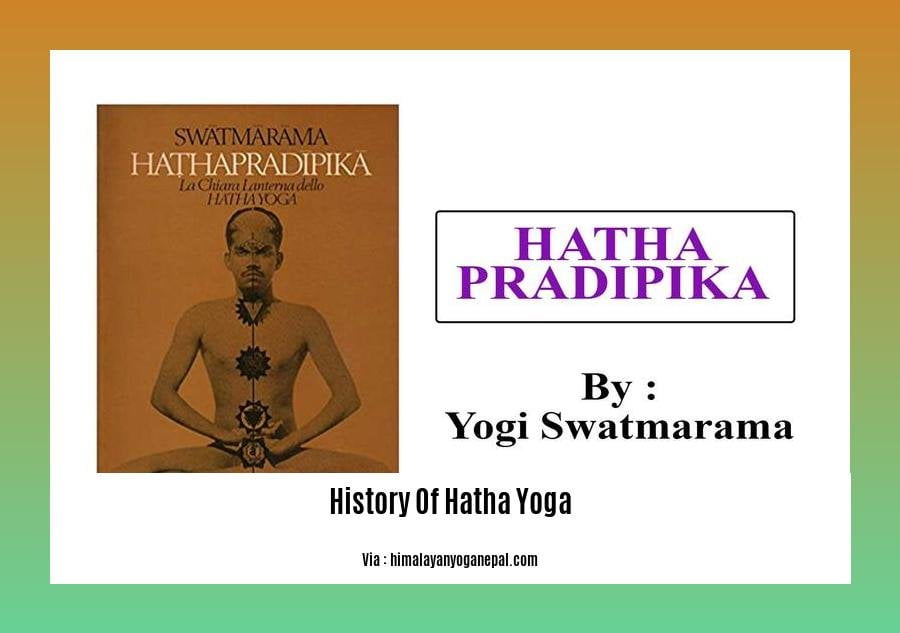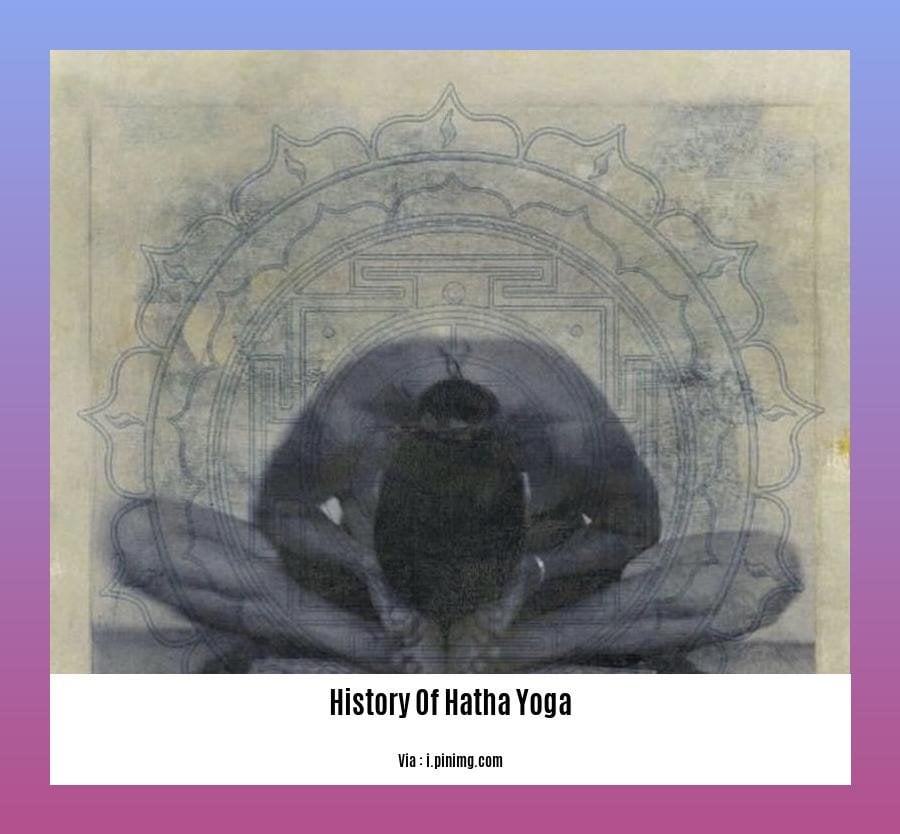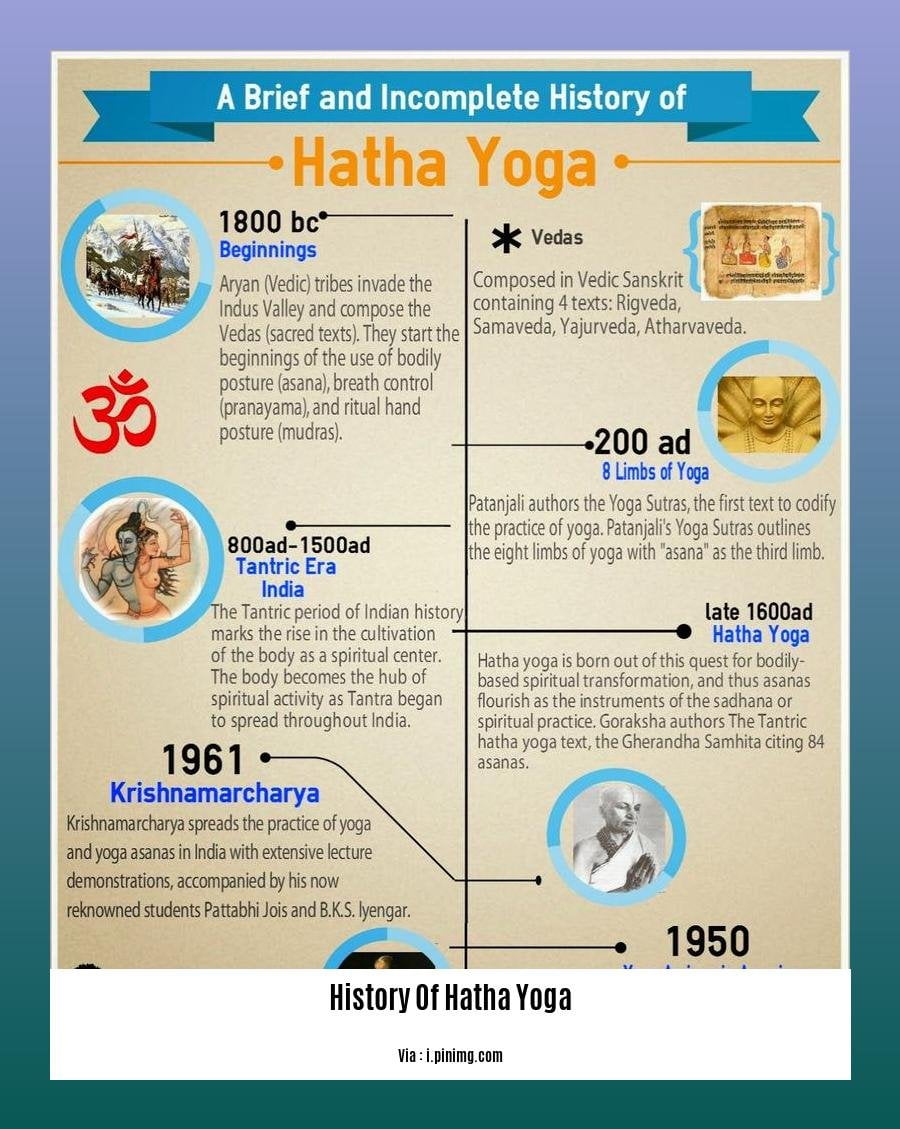Embark on a captivating journey through the annals of time as we unveil the rich history of hatha yoga, an ancient practice that has profoundly shaped the world of modern yoga. From its humble origins in ancient India to its remarkable evolution across diverse traditions, hatha yoga’s legacy is a tapestry woven with profound philosophies, transformative practices, and a quest for spiritual enlightenment. Join us as we delve into the depths of this ancient practice, exploring its profound impact on the physical, mental, and spiritual well-being of countless individuals throughout history.
Key Takeaways:
Hatha yoga has its roots in yogic traditions dating back to the 2nd century BCE.
Classical Hatha yoga developed in the 15th century with guidance on yoga settings, postures, breathing exercises, mudras, and meditation for spiritual growth.
Swatmarama composed the yoga manual ‘Hathapradipika’ in the 15th century.
Hatha yoga was introduced to America by Swami Vivekananda in 1893 as a spiritual practice.
Hatha yoga was taught as a healing system for the mind and to prepare the body for meditation.
Hatha yoga is characterized by a focus on physical postures, breathing exercises, and meditation to achieve spiritual growth.
History of Hatha Yoga

The ancient practice of hatha yoga has weaved its way through centuries, leaving an imprint on global wellness and spirituality. Join us as we explore the rich history of hatha yoga, tracing its transformative journey from ancient origins to modern-day practices.
Unveiling the Roots: Yogic Traditions of the Past
Yoga’s roots trace back to the 2nd century BCE, deeply embedded in yogic traditions that revered spiritual growth and physical well-being. These early yogis sought to attain enlightenment through meditation and physical practices aimed at purifying the body and mind.
The Dawn of Hatha Yoga: A Classical Revolution
In the 15th century, hatha yoga emerged as a distinct form of yoga, codified by the sage Swatmarama in the seminal text, Hathapradipika. This comprehensive manual outlined the principles of hatha yoga, encompassing postures (asanas), breathing exercises (pranayama), meditation techniques, and more.
Embracing Hatha’s Multifaceted Nature
Hatha yoga’s essence lies in its balanced approach to spiritual and physical well-being. It emphasizes the importance of physical postures, not just for flexibility and strength but also for aligning the body’s energy channels and promoting inner peace.
Hatha’s Passage to the West: A Journey of Transformation
Swami Vivekananda played a pivotal role in introducing hatha yoga to the Western world. His teachings at the 1893 World’s Parliament of Religions in Chicago sparked curiosity and fascination, paving the way for hatha yoga’s global expansion.
Evolution and Adaptation: Hatha’s Journey Continues
Over the decades, hatha yoga underwent adaptations to suit various needs and preferences. Different schools and lineages emerged, each emphasizing specific aspects of the practice, leading to a diverse landscape of hatha yoga styles we see today.
Hatha’s Impact: A Legacy of Mind-Body Harmony
The history of hatha yoga is a testament to its profound impact on modern-day yoga practices. It laid the foundation for many popular styles, such as Vinyasa, Ashtanga, and Iyengar yoga, highlighting the enduring significance of its teachings.
Exploring the Profound Legacy of Hatha Yoga
Stepping into the world of hatha yoga is akin to embarking on a transformative journey, where practitioners delve into the depths of their being, aligning body, mind, and spirit.
Unifying Body and Mind: A Harmonious Dance
Hatha yoga’s practices, from asanas to pranayama, are designed to cultivate a harmonious union between the physical body and the inner workings of the mind. This integration promotes vitality, flexibility, and mental clarity.
The Path to Inner Peace: Stillness Within
Through meditation, a cornerstone of hatha yoga, practitioners discover the stillness within, developing the capacity for deep relaxation, self-awareness, and profound connection with the present moment.
Embark on Your Own Yogic Journey
Whether you seek physical fitness, mental tranquility, or spiritual growth, hatha yoga offers a path to a more fulfilling and harmonious existence. Its rich history and diverse lineages provide a wealth of practices to suit every seeker.
So, step onto your yoga mat, embrace the wisdom of hatha yoga, and embark on a journey of self-discovery and transformation, one pose, one breath at a time.
You may not be aware of the rich and interesting history behind the hair waxing. To immerse yourself in the fascinating journey of hair waxing since the ancient times, we have a very well-structured page containing all the historic details you may be interested in! Explore the history of hair waxing today!
Evolution of Hatha Yoga Traditions: Exploring the diverse lineages of hatha yoga, including the lineages of Sivananda, Iyengar, and Ashtanga, and their unique contributions to modern yoga practices.

From ancient roots to modern practices, hatha yoga has traveled an extensive path, enriching the world of yoga with a multitude of traditions and practices. Let’s embark on a journey through time, uncovering the evolution of hatha yoga and the profound imprints left by the Sivananda, Iyengar, and Ashtanga lineages.
A Tapestry of Hatha Traditions:
Sivananda Lineage: An embodiment of spiritual and physical harmony, the Sivananda lineage emphasizes the integration of asana, pranayama, and meditation. Inspired by Swami Sivananda’s teachings, this tradition promotes a holistic approach to yoga, focusing on alignment, flexibility, and overall well-being.
Iyengar Lineage: Precision and attention to detail define the Iyengar lineage. Rooted in B.K.S. Iyengar’s teachings, this tradition emphasizes the use of props to aid alignment and enhance the precision of each pose. Iyengar yoga is renowned for its therapeutic benefits and emphasis on proper technique.
Ashtanga Lineage: A vigorous and dynamic practice, the Ashtanga lineage traces its origins to K. Pattabhi Jois. This tradition follows a set sequence of poses, emphasizing strength, stamina, and synchronization of breath with movement. Ashtanga yoga is a rigorous practice that offers profound physical and mental benefits.
Unique contributions to Modern Yoga Practices:
- Sivananda Lineage:
- Introduced the concept of daily yoga practice (sadhana) and a balanced lifestyle, emphasizing ethical conduct, proper diet, and meditation.
- Developed a system of 12 basic postures, serving as a foundation for many modern yoga styles.
Pioneered yoga teacher training programs, spreading the teachings of yoga worldwide.
Iyengar Lineage:
- Refined the use of props to enhance alignment and promote safety in yoga practice.
- Developed a systematic approach to teaching yoga, with a focus on precision and detail.
Emphasized the therapeutic potential of yoga, making it accessible to practitioners with injuries or physical limitations.
Ashtanga Lineage:
- Introduced the concept of vinyasa, linking breath with movement, creating a dynamic and flowing practice.
- Emphasized the importance of a consistent and disciplined practice, promoting physical strength, flexibility, and mental focus.
- Pioneered the Mysore style of teaching, which allows students to practice at their own pace under the guidance of a teacher.
Key Takeaways:
- Hatha yoga has evolved over time, giving rise to diverse lineages with unique approaches and contributions.
- The Sivananda lineage emphasizes spiritual and physical harmony, promoting a holistic approach to yoga.
- The Iyengar lineage focuses on precision and alignment, using props to enhance the safety and effectiveness of yoga practice.
- The Ashtanga lineage offers a dynamic and vigorous practice, emphasizing strength, stamina, and breath synchronization.
- These lineages have profoundly influenced modern yoga practices, shaping the way yoga is taught and practiced worldwide.
[Sources]:
– Yoga History and Traditions
– Evolution of Yoga
Hatha Yoga and Westernization: Investigating the role of Western yoga pioneers, such as Swami Vivekananda and B.K.S. Iyengar, in introducing hatha yoga to the West and shaping its global popularity.
Visualize a journey through time, one that unveils the rich history of hatha yoga, an ancient practice with deep roots that has found its way into the modern Western world. But how did this significant transmission occur? Enter the influential figures of Swami Vivekananda and B.K.S. Iyengar, pioneers who played a pivotal role in introducing and popularizing hatha yoga in the West.
The Role of Swami Vivekananda:
Swami Vivekananda, a revered Indian monk and philosopher, left an indelible mark on the Western yoga landscape when he introduced the world to the spiritual and philosophical aspects of hatha yoga. His teachings at the World Parliament of Religions in Chicago in 1893 ignited curiosity and sparked a growing interest in yoga among Western audiences. Through his eloquent words, Vivekananda emphasized the importance of self-realization, meditation, and the harmonious union of body and mind, principles that resonated deeply with those seeking a deeper connection to themselves and the world around them.
The Influence of B.K.S. Iyengar:
B.K.S. Iyengar, another influential figure in the Westernization of hatha yoga, focused on the physical aspects of the practice. His meticulous approach to alignment and precision in postures (asanas) revolutionized the way yoga was taught and practiced in the West. Iyengar developed the popular Iyengar Yoga style, characterized by the use of props such as blocks, straps, and bolsters to assist students in achieving proper alignment and deepening their practice. His emphasis on safety, precision, and attention to detail made yoga accessible to a broader range of individuals, including those with injuries or physical limitations.
The Impact of Western Yoga Pioneers:
The combined efforts of Swami Vivekananda and B.K.S. Iyengar, along with other dedicated yogis, contributed significantly to the global popularity of hatha yoga. Their teachings and practices laid the foundation for the diverse styles of yoga prevalent in the West today. From the dynamic flow of Vinyasa to the restorative sequences of Yin Yoga, the legacy of these pioneers continues to shape the way we practice and experience yoga in the modern world.
Key Takeaways:
Swami Vivekananda introduced the spiritual and philosophical aspects of hatha yoga to the West, emphasizing self-realization and the union of body and mind.
B.K.S. Iyengar revolutionized the physical practice of yoga through his focus on alignment, precision, and the use of props, making yoga accessible to a wider range of individuals.
The teachings and practices of these pioneers laid the foundation for the diverse styles of yoga practiced in the West today.
Hatha yoga has gained immense popularity in the Western world due to its holistic approach to well-being, combining physical postures, breathing techniques, and meditation.
The legacy of Swami Vivekananda and B.K.S. Iyengar continues to shape the way yoga is taught and practiced globally.
Citations:
[1]
[2]
Contemporary Trends in Hatha Yoga: Discussing the current landscape of hatha yoga, including the rise of modern yoga styles, the integration of yoga into fitness and wellness, and the ongoing evolution of yoga practices.
Through centuries of evolution, hatha yoga, with its roots in ancient yogic traditions, has undergone a remarkable transformation in the contemporary landscape of yoga. Let’s unveil the fascinating trends that are shaping the world of hatha yoga today.
The Rise of Modern Yoga Styles:
In the realm of modern yoga, we witness the flourishing of diverse styles, each catering to unique needs and preferences. From the dynamic flow of Vinyasa to the precise alignment of Iyengar, these styles offer a spectrum of options for practitioners.
Vinyasa yoga: A vigorous practice that synchronizes breath with movement, creating a flowing sequence of postures.
Ashtanga yoga: A physically demanding style with a set series of postures, emphasizing strength, flexibility, and stamina.
Iyengar yoga: Known for its focus on alignment and precision, using props to enhance proper form and reduce the risk of injury.
Yin yoga: A slower-paced practice that targets connective tissues, promoting deep relaxation and flexibility.
Integration of Yoga into Fitness and Wellness:
The fitness and wellness industry has embraced the benefits of yoga, integrating it into various programs and offerings:
Yoga for fitness: Yoga is increasingly incorporated into fitness routines for its ability to improve flexibility, strength, and balance, complementing traditional fitness training.
Yoga for stress relief: Recognizing its stress-reducing effects, yoga is incorporated into wellness programs to promote relaxation, mindfulness, and overall well-being.
Yoga for rehabilitation: Yoga is used in rehabilitation settings to improve mobility, reduce pain, and enhance physical function after injuries or surgeries.
Yoga for mental health: Yoga’s positive impact on mental health, including anxiety and depression, has led to its inclusion in mental health programs.
Ongoing Evolution of Yoga Practices:
The evolution of yoga continues, with contemporary trends shaping its future direction:
Yoga for diverse populations: Yoga is becoming more accessible to diverse populations, with modifications and adaptations to cater to individuals with different abilities, ages, and health conditions.
Yoga and technology: Technology is merging with yoga, offering virtual classes, online studios, and wearable devices that track progress and provide feedback.
Yoga and sustainability: Yoga practitioners are increasingly mindful of sustainability, incorporating eco-friendly practices, such as using recycled mats and supporting local yoga studios.
Yoga and social justice: Yoga is used as a tool for social justice, promoting inclusivity, equity, and diversity within the yoga community.
Key Takeaways:
Contemporary hatha yoga encompasses diverse styles, catering to various needs and preferences.
Yoga has integrated into the fitness and wellness industry, offering benefits for physical fitness, stress relief, rehabilitation, and mental health.
The evolution of yoga continues, with trends such as accessibility, technology, sustainability, and social justice shaping its future.
[Contemporary Trends in Hatha Yoga: Discussing the current landscape of hatha yoga, including the rise of modern yoga styles, the integration of yoga into fitness and wellness, and the ongoing evolution of yoga practices.]
Sources:
How Modern Yoga Is Different From Traditional Hatha Yoga
The History and Evolution of Hatha Yoga
FAQ
Q1: What are the origins of hatha yoga?
A1: Hatha yoga originated in ancient India, with roots in yogic traditions dating back to the 2nd century BCE. It was further developed in the 15th century, leading to the creation of classical hatha yoga.
Q2: Who composed the yoga manual ‘Hathapradipika’?
A2: Swatmarama composed the yoga manual ‘Hathapradipika’ in the 15th century. This text is considered a foundational work in the history of hatha yoga.
Q3: When was hatha yoga brought to the Americas?
A3: Hatha yoga was brought to America by Swami Vivekananda in 1893. He introduced the spiritual and philosophical aspects of hatha yoga to Western audiences.
Q4: What was the initial purpose of hatha yoga?
A4: Hatha yoga was initially taught as a healing system for the mind and body, preparing individuals for seated meditation. It aimed to improve physical and mental well-being as a foundation for spiritual growth.
Q5: What are the key components of hatha yoga?
A5: Hatha yoga is characterized by a focus on physical postures (asanas), breathing exercises (pranayama), and meditation. It combines physical and mental practices to achieve spiritual growth and a state of unified consciousness.
- Senior at What Age: Benefits & Eligibility Guide - March 29, 2025
- Unlocking Senior Benefits: How Old is a Senior? Your Complete Guide - March 29, 2025
- Master Russian Politeness:A Guide to Saying Please - March 29, 2025
















